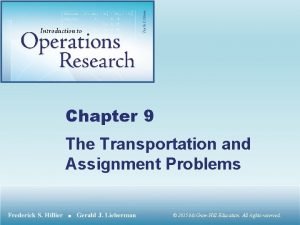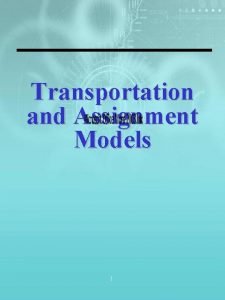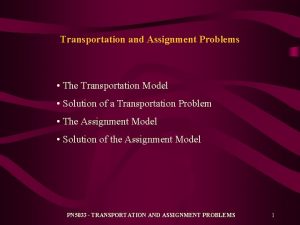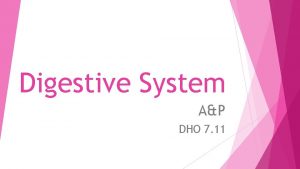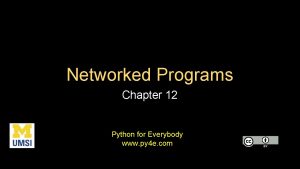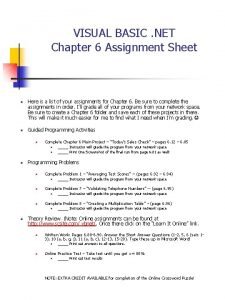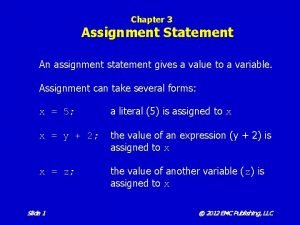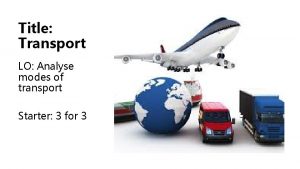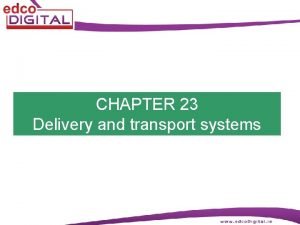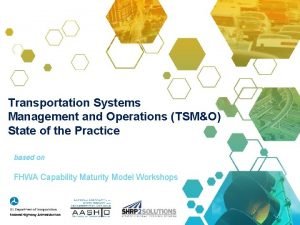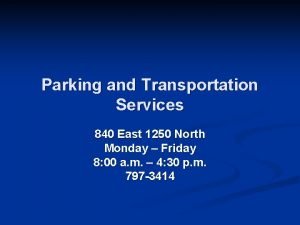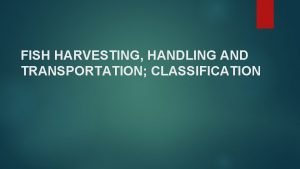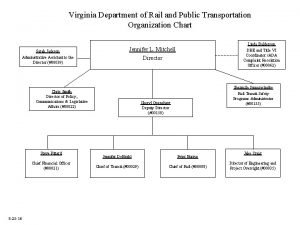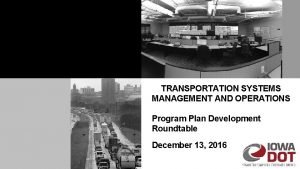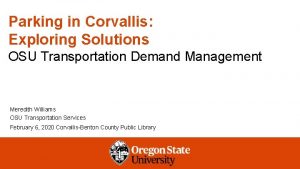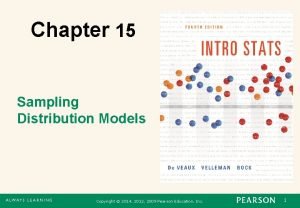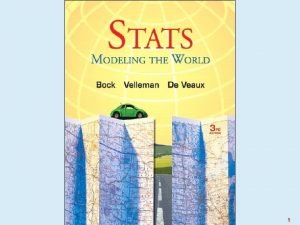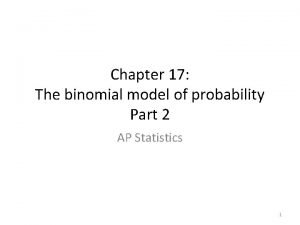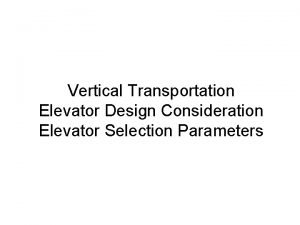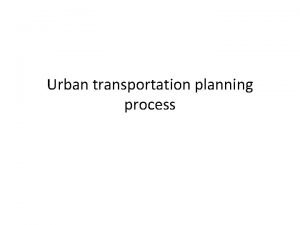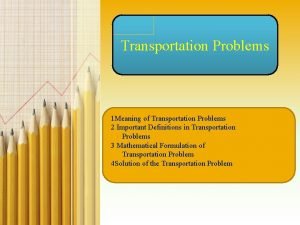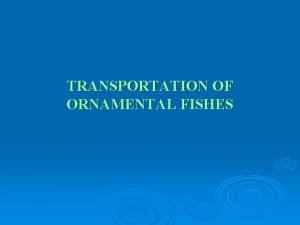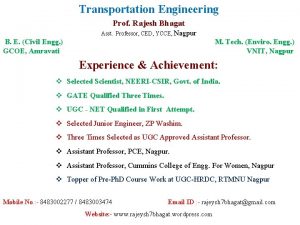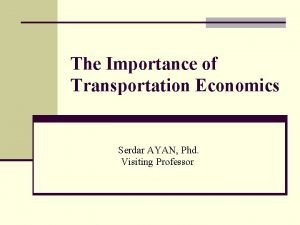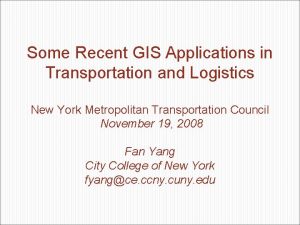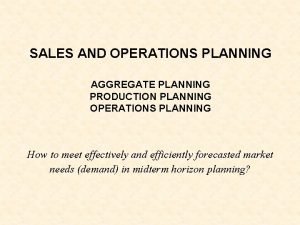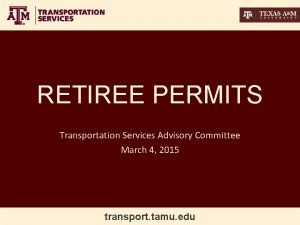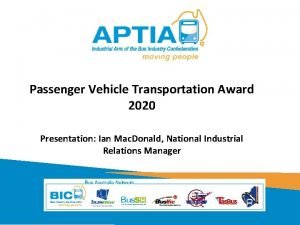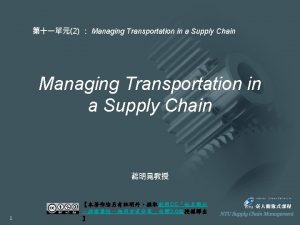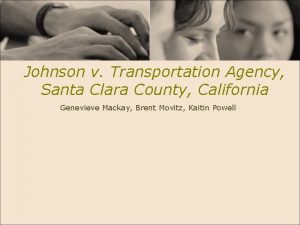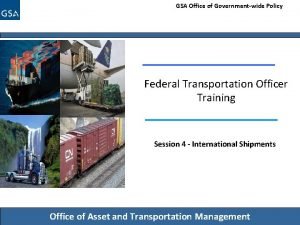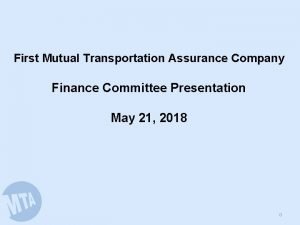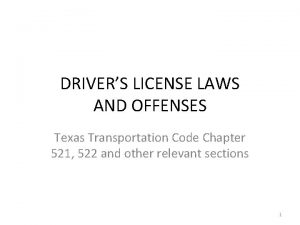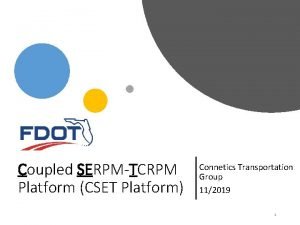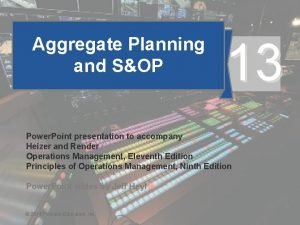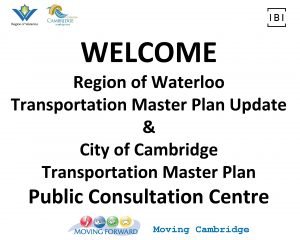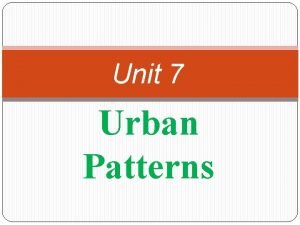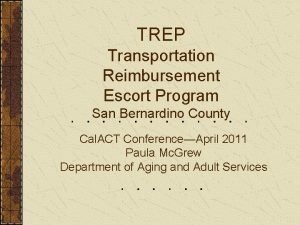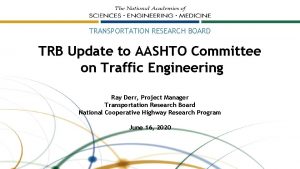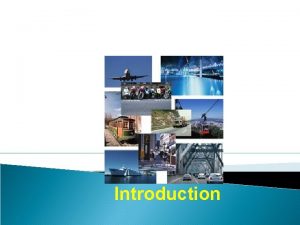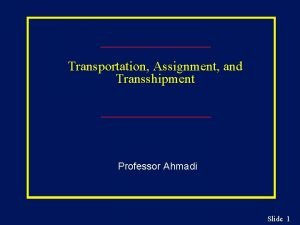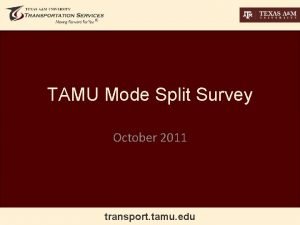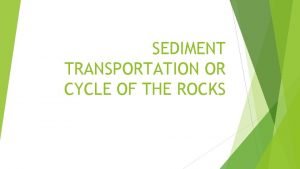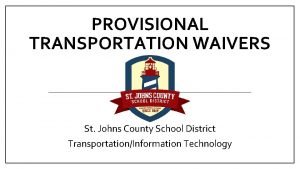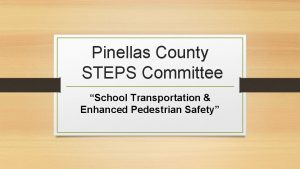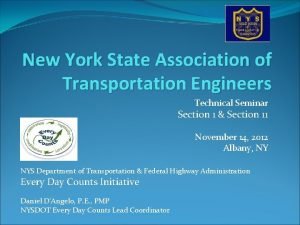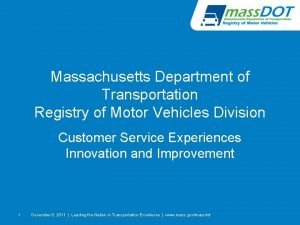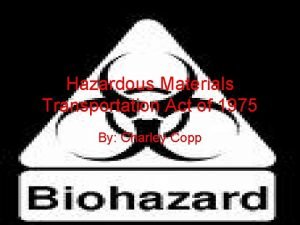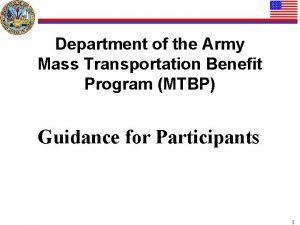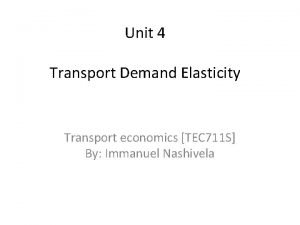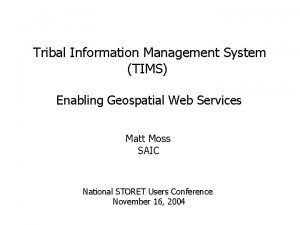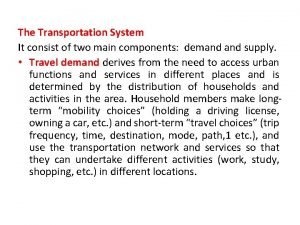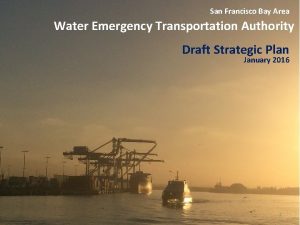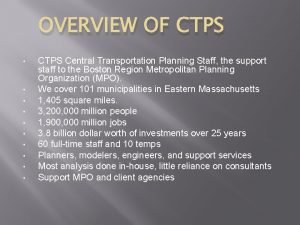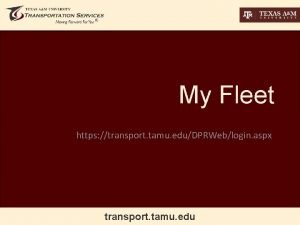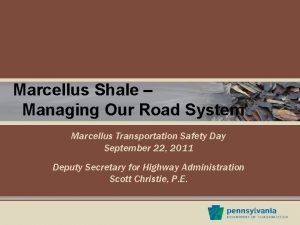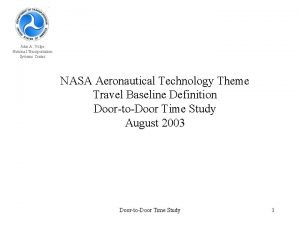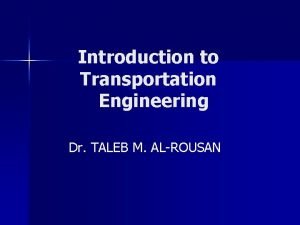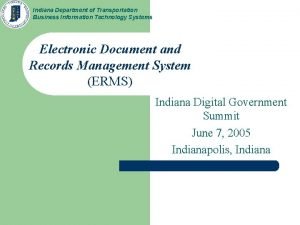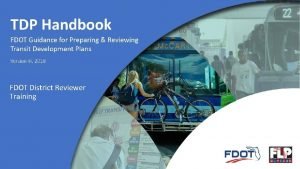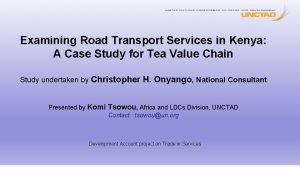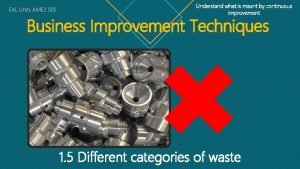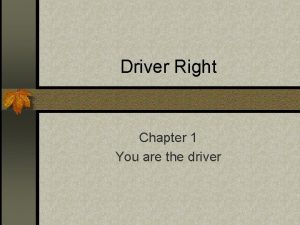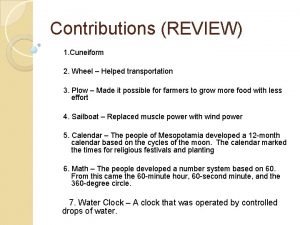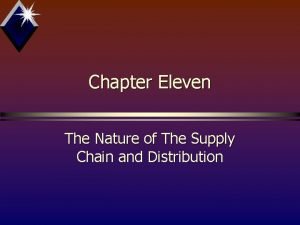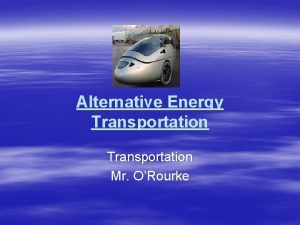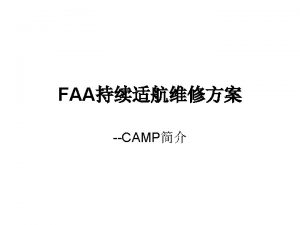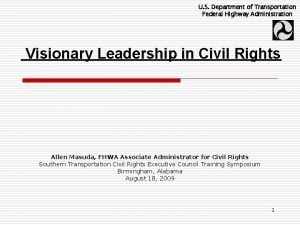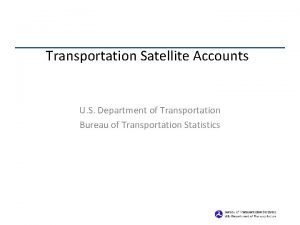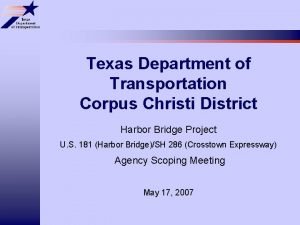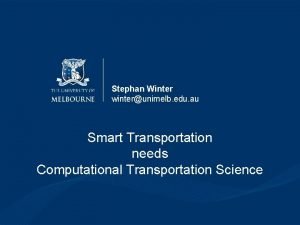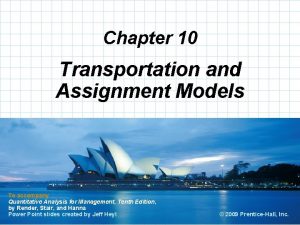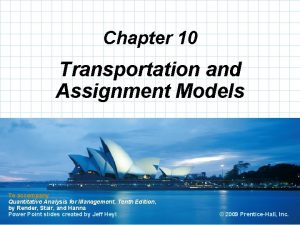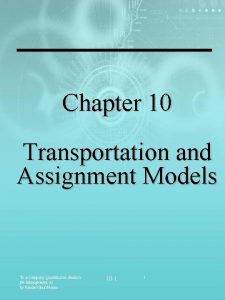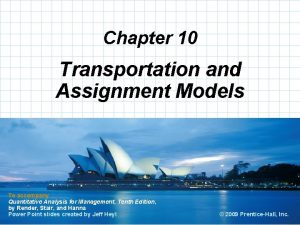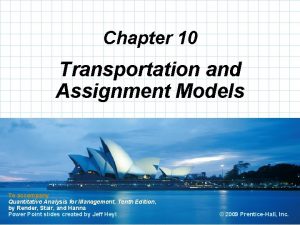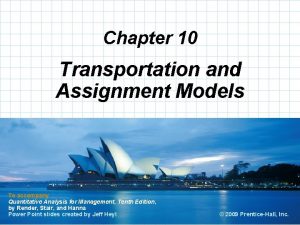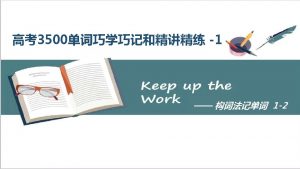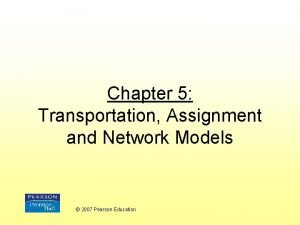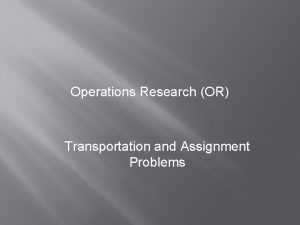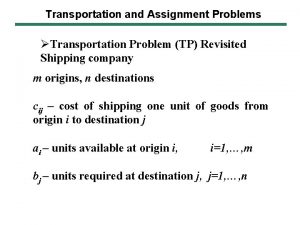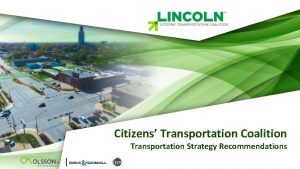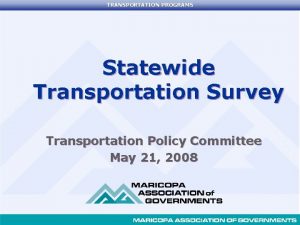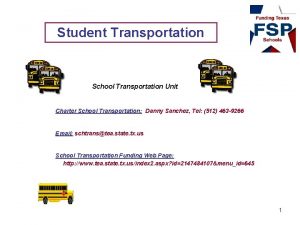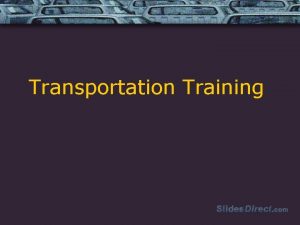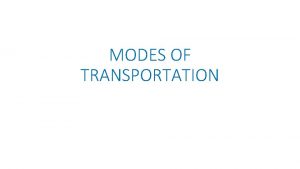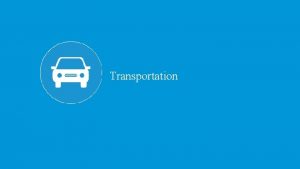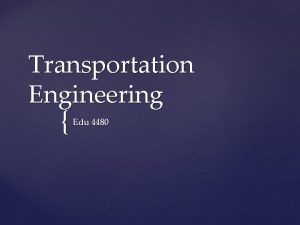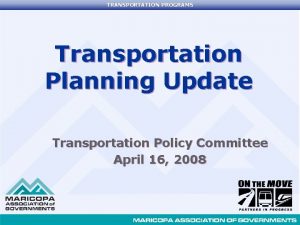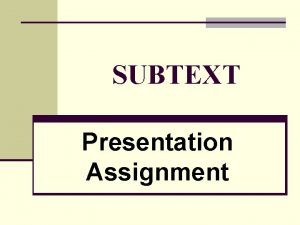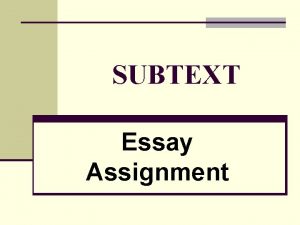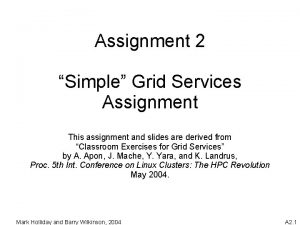Chapter 10 Transportation and Assignment Models To accompany



























































































































- Slides: 123

Chapter 10 Transportation and Assignment Models To accompany Quantitative Analysis for Management, Tenth Edition, by Render, Stair, and Hanna Power Point slides created by Jeff Heyl © 2008 Prentice-Hall, Inc. © 2009 Prentice-Hall, Inc.

Learning Objectives After completing this chapter, students will be able to: 1. 2. 3. 4. Structure special LP problems using the transportation and assignment models Use the northwest corner, VAM, MODI, and stepping-stone methods Solve facility location and other application problems with transportation models Solve assignment problems with the Hungarian (matrix reduction) method © 2009 Prentice-Hall, Inc. 10 – 2

Chapter Outline 10. 1 Introduction 10. 2 Setting Up a Transportation Problem 10. 3 Developing an Initial Solution: Northwest Corner Rule 10. 4 Stepping-Stone Method: Finding a Least-Cost Solution 10. 5 MODI Method 10. 6 Vogel’s Approximation Method: Another Way to Find an Initial Solution 10. 7 Unbalanced Transportation Problems © 2009 Prentice-Hall, Inc. 10 – 3

Chapter Outline 10. 8 10. 9 10. 10 10. 11 10. 12 10. 13 10. 14 10. 15 Degeneracy in Transportation Problems More Than One Optimal Solution Maximization Transportation Problems Unacceptable or Prohibited Routes Facility Location Analysis Assignment Model Approach Unbalanced Assignment Problems Maximization Assignment Problems © 2009 Prentice-Hall, Inc. 10 – 4

Introduction n In this chapter we will explore two special linear programming models n The transportation model n The assignment model n Because of their structure, they can be solved more efficiently than the simplex method n These problems are members of a category of LP techniques called network flow problems © 2009 Prentice-Hall, Inc. 10 – 5

Introduction n Transportation model n The transportation problem deals with the distribution of goods from several points of supply (sources) sources to a number of points of demand (destinations) destinations n Usually we are given the capacity of goods at each source and the requirements at each destination n Typically the objective is to minimize total transportation and production costs © 2009 Prentice-Hall, Inc. 10 – 6

Introduction n Example of a transportation problem in a network format Factories (Sources) Warehouses (Destinations) 100 Units Des Moines Albuquerque 300 Units Evansville Boston 200 Units 300 Units Fort Lauderdale Cleveland 200 Units Capacities Shipping Routes Requirements Figure 10. 1 © 2009 Prentice-Hall, Inc. 10 – 7

Introduction n Assignment model n The assignment problem refers to the class of LP problems that involve determining the most efficient assignment of resources to tasks n The objective is most often to minimize total costs or total time to perform the tasks at hand n One important characteristic of assignment problems is that only one job or worker can be assigned to one machine or project © 2009 Prentice-Hall, Inc. 10 – 8

Introduction n Special-purpose algorithms n Although standard LP methods can be used to solve transportation and assignment problems, special-purpose algorithms have been developed that are more efficient n They still involve finding and initial solution and developing improved solutions until an optimal solution is reached n They are fairly simple in terms of computation © 2009 Prentice-Hall, Inc. 10 – 9

Introduction n Streamlined versions of the simplex method are important for two reasons 1. Their computation times are generally 100 times faster 2. They require less computer memory (and hence can permit larger problems to be solved) n Two common techniques for developing initial solutions are the northwest corner method and Vogel’s approximation n The initial solution is evaluated using either the stepping-stone method or the modified distribution (MODI) method n We also introduce a solution procedure called the Hungarian method, method Flood’s technique, technique or the reduced matrix method © 2009 Prentice-Hall, Inc. 10 – 10

Setting Up a Transportation Problem n The Executive Furniture Corporation manufactures office desks at three locations: Des Moines, Evansville, and Fort Lauderdale n The firm distributes the desks through regional warehouses located in Boston, Albuquerque, and Cleveland n Estimates of the monthly production capacity of each factory and the desks needed at each warehouse are shown in Figure 10. 1 © 2009 Prentice-Hall, Inc. 10 – 11

Setting Up a Transportation Problem n Production costs are the same at the three factories so the only relevant costs are shipping from each source to each destination n Costs are constant no matter the quantity shipped n The transportation problem can be described as how to select the shipping routes to be used and the number of desks to be shipped on each route so as to minimize total transportation cost n Restrictions regarding factory capacities and warehouse requirements must be observed © 2009 Prentice-Hall, Inc. 10 – 12

Setting Up a Transportation Problem n The first step is setting up the transportation table n Its purpose is to summarize all the relevant data and keep track of algorithm computations Transportation costs per desk for Executive Furniture TO FROM ALBUQUERQUE BOSTON CLEVELAND DES MOINES $5 $4 $3 EVANSVILLE $8 $4 $3 FORT LAUDERDALE $9 $7 $5 Table 10. 1 © 2009 Prentice-Hall, Inc. 10 – 13

Setting Up a Transportation Problem n Geographical locations of Executive Furniture’s factories and warehouses Boston Cleveland Factory Des Moines Evanston Warehouse Albuquerque Fort Lauderdale Figure 10. 2 © 2009 Prentice-Hall, Inc. 10 – 14

Setting Up a Transportation Problem n Transportation table for Executive Furniture WAREHOUSE AT ALBUQUERQUE WAREHOUSE AT BOSTON DES MOINES FACTORY $5 $4 $3 EVANSVILLE FACTORY $8 $4 $3 FORT LAUDERDALE FACTORY $9 $7 $5 TO FROM WAREHOUSE REQUIREMENTS Table 10. 2 300 200 Cost of shipping 1 unit from Cleveland Fort Lauderdale factory to warehouse Boston warehouse demand WAREHOUSE AT CLEVELAND 200 Total supply and demand Des Moines capacity constraint FACTORY CAPACITY 100 300 700 Cell representing a source-to-destination (Evansville to Cleveland) shipping assignment that could be made © 2009 Prentice-Hall, Inc. 10 – 15

Setting Up a Transportation Problem n In this table, total factory supply exactly equals total warehouse demand n When equal demand supply occur, a balanced problem is said to exist n This is uncommon in the real world and we have techniques to deal with unbalanced problems © 2009 Prentice-Hall, Inc. 10 – 16

Developing an Initial Solution: Northwest Corner Rule n Once we have arranged the data in a table, we must establish an initial feasible solution n One systematic approach is known as the northwest corner rule n Start in the upper left-hand cell and allocate units to shipping routes as follows 1. Exhaust the supply (factory capacity) of each row before moving down to the next row 2. Exhaust the demand (warehouse) requirements of each column before moving to the right to the next column 3. Check that all supply and demand requirements are met. n In this problem it takes five steps to make the initial shipping assignments © 2009 Prentice-Hall, Inc. 10 – 17

Developing an Initial Solution: Northwest Corner Rule 1. Beginning in the upper left hand corner, we assign 100 units from Des Moines to Albuquerque. This exhaust the supply from Des Moines but leaves Albuquerque 200 desks short. We move to the second row in the same column. TO FROM ALBUQUERQUE (A) BOSTON (B) CLEVELAND (C) $5 $4 $3 EVANSVILLE (E) $8 $4 $3 FORT LAUDERDALE (F) $9 $7 $5 DES MOINES (D) WAREHOUSE REQUIREMENTS 100 300 200 FACTORY CAPACITY 100 300 700 © 2009 Prentice-Hall, Inc. 10 – 18

Developing an Initial Solution: Northwest Corner Rule 2. Assign 200 units from Evansville to Albuquerque. This meets Albuquerque’s demand. Evansville has 100 units remaining so we move to the right to the next column of the second row. TO FROM ALBUQUERQUE (A) DES MOINES (D) 100 EVANSVILLE (E) 200 FORT LAUDERDALE (F) WAREHOUSE REQUIREMENTS 300 BOSTON (B) CLEVELAND (C) $5 $4 $3 $8 $4 $3 $9 $7 $5 200 FACTORY CAPACITY 100 300 700 © 2009 Prentice-Hall, Inc. 10 – 19

Developing an Initial Solution: Northwest Corner Rule 3. Assign 100 units from Evansville to Boston. The Evansville supply has now been exhausted but Boston is still 100 units short. We move down vertically to the next row in the Boston column. TO FROM ALBUQUERQUE (A) DES MOINES (D) 100 EVANSVILLE (E) 200 $5 $8 100 $9 FORT LAUDERDALE (F) WAREHOUSE REQUIREMENTS BOSTON (B) 300 200 CLEVELAND (C) $4 $3 $7 $5 200 FACTORY CAPACITY 100 300 700 © 2009 Prentice-Hall, Inc. 10 – 20

Developing an Initial Solution: Northwest Corner Rule 4. Assign 100 units from Fort Lauderdale to Boston. This fulfills Boston’s demand Fort Lauderdale still has 200 units available. TO FROM ALBUQUERQUE (A) DES MOINES (D) 100 EVANSVILLE (E) 200 WAREHOUSE REQUIREMENTS $5 $8 $9 FORT LAUDERDALE (F) 300 BOSTON (B) 100 200 CLEVELAND (C) $4 $3 $7 $5 200 FACTORY CAPACITY 100 300 700 © 2009 Prentice-Hall, Inc. 10 – 21

Developing an Initial Solution: Northwest Corner Rule 5. Assign 200 units from Fort Lauderdale to Cleveland. This exhausts Fort Lauderdale’s supply and Cleveland’s demand. The initial shipment schedule is now complete. Table 10. 3 TO FROM ALBUQUERQUE (A) DES MOINES (D) 100 EVANSVILLE (E) 200 WAREHOUSE REQUIREMENTS $5 $8 $9 FORT LAUDERDALE (F) 300 BOSTON (B) 100 200 CLEVELAND (C) $4 $3 $7 200 $5 FACTORY CAPACITY 100 300 700 © 2009 Prentice-Hall, Inc. 10 – 22

Developing an Initial Solution: Northwest Corner Rule n We can easily compute the cost of this shipping assignment ROUTE UNITS SHIPPED PER UNIT x COST ($) TOTAL COST ($) FROM TO D A 100 5 500 E A 200 8 1, 600 E B 100 4 400 F B 100 7 700 F C 200 5 1, 000 = 4, 200 n This solution is feasible but we need to check to see if it is optimal © 2009 Prentice-Hall, Inc. 10 – 23

Stepping-Stone Method: Finding a Least Cost Solution n The stepping-stone method is an iterative technique for moving from an initial feasible solution to an optimal feasible solution n There are two distinct parts to the process n Testing the current solution to determine if improvement is possible n Making changes to the current solution to obtain an improved solution n This process continues until the optimal solution is reached © 2009 Prentice-Hall, Inc. 10 – 24

Stepping-Stone Method: Finding a Least Cost Solution n There is one very important rule n The number of occupied routes (or squares) must always be equal to one less than the sum of the number of rows plus the number of columns n In the Executive Furniture problem this means the initial solution must have 3 + 3 – 1 = 5 squares used Occupied shipping routes (squares) Number = of rows + Number of columns – 1 n When the number of occupied rows is less than this, the solution is called degenerate © 2009 Prentice-Hall, Inc. 10 – 25

Testing the Solution for Possible Improvement n The stepping-stone method works by testing each unused square in the transportation table to see what would happen to total shipping costs if one unit of the product were tentatively shipped on an unused route n There are five steps in the process © 2009 Prentice-Hall, Inc. 10 – 26

Five Steps to Test Unused Squares with the Stepping-Stone Method 1. Select an unused square to evaluate 2. Beginning at this square, trace a closed path back to the original square via squares that are currently being used with only horizontal or vertical moves allowed 3. Beginning with a plus (+) sign at the unused square, place alternate minus (–) signs and plus signs on each corner square of the closed path just traced © 2009 Prentice-Hall, Inc. 10 – 27

Five Steps to Test Unused Squares with the Stepping-Stone Method 4. Calculate an improvement index by adding together the unit cost figures found in each square containing a plus sign and then subtracting the unit costs in each square containing a minus sign 5. Repeat steps 1 to 4 until an improvement index has been calculated for all unused squares. If all indices computed are greater than or equal to zero, an optimal solution has been reached. If not, it is possible to improve the current solution and decrease total shipping costs. © 2009 Prentice-Hall, Inc. 10 – 28

Five Steps to Test Unused Squares with the Stepping-Stone Method n For the Executive Furniture Corporation data Steps 1 and 2. 2 Beginning with Des Moines–Boston route we trace a closed path using only currently occupied squares, alternately placing plus and minus signs in the corners of the path n In a closed path, path only squares currently used for shipping can be used in turning corners n Only one closed route is possible for each square we wish to test © 2009 Prentice-Hall, Inc. 10 – 29

Five Steps to Test Unused Squares with the Stepping-Stone Method Step 3. 3 We want to test the cost-effectiveness of the Des Moines–Boston shipping route so we pretend we are shipping one desk from Des Moines to Boston and put a plus in that box n But if we ship one more unit out of Des Moines we will be sending out 101 units n Since the Des Moines factory capacity is only 100, we must ship fewer desks from Des Moines to Albuquerque so we place a minus sign in that box n But that leaves Albuquerque one unit short so we must increase the shipment from Evansville to Albuquerque by one unit and so on until we complete the entire closed path © 2009 Prentice-Hall, Inc. 10 – 30

Five Steps to Test Unused Squares with the Stepping-Stone Method n Evaluating the unused Warehouse A Des Moines–Boston shipping route Factory D Factory E TO FROM ALBUQUERQUE DES MOINES 100 EVANSVILLE 200 WAREHOUSE REQUIREMENTS $5 $8 $9 FORT LAUDERDALE 300 BOSTON 100 200 CLEVELAND $4 $3 $7 200 $5 Warehouse B $5 100 – + $4 + $8 200 – $4 100 FACTORY CAPACITY 100 300 700 Table 10. 4 © 2009 Prentice-Hall, Inc. 10 – 31

Five Steps to Test Unused Squares with the Stepping-Stone Method n Evaluating the unused Warehouse A Des Moines–Boston shipping route Factory D Factory E TO FROM ALBUQUERQUE DES MOINES 100 EVANSVILLE 200 WAREHOUSE REQUIREMENTS $5 $8 $9 FORT LAUDERDALE 300 BOSTON 100 200 CLEVELAND $4 $3 $7 200 $5 Warehouse B $5 99 1 100 – 201 + $4 + $8 200 99 – $4 100 FACTORY CAPACITY 100 300 700 Table 10. 4 © 2009 Prentice-Hall, Inc. 10 – 32

Five Steps to Test Unused Squares with the Stepping-Stone Method n Evaluating the unused Warehouse A Des Moines–Boston shipping route Factory D Factory E TO FROM ALBUQUERQUE DES MOINES 100 EVANSVILLE 200 WAREHOUSE REQUIREMENTS $5 $8 $9 FORT LAUDERDALE 300 BOSTON CLEVELAND $4 100 200 $3 $4 $7 $3 200 $5 Warehouse B $5 99 1 100 – 201 + $4 + $8 200 99 – $4 100 FACTORY Result CAPACITY of Proposed Shift in Allocation 100 = 1 x $4 – 1 x $5 300 + 1 x $8 – 1 x $4 = +$3 300 700 Table 10. 4 © 2009 Prentice-Hall, Inc. 10 – 33

Five Steps to Test Unused Squares with the Stepping-Stone Method Step 4. 4 We can now compute an improvement index (Iij) for the Des Moines–Boston route n We add the costs in the squares with plus signs and subtract the costs in the squares with minus signs Des Moines– Boston index = IDB = +$4 – $5 + $5 – $4 = + $3 n This means for every desk shipped via the Des Moines–Boston route, total transportation cost will increase by $3 over their current level © 2009 Prentice-Hall, Inc. 10 – 34

Five Steps to Test Unused Squares with the Stepping-Stone Method Step 5. 5 We can now examine the Des Moines– Cleveland unused route which is slightly more difficult to draw n Again we can only turn corners at squares that represent existing routes n We must pass through the Evansville–Cleveland square but we can not turn there or put a + or – sign n The closed path we will use is + DC – DA + EA – EB + FB – FC © 2009 Prentice-Hall, Inc. 10 – 35

Five Steps to Test Unused Squares with the Stepping-Stone Method n Evaluating the Des Moines–Cleveland shipping route TO FROM DES MOINES EVANSVILLE ALBUQUERQUE – 100 + 200 WAREHOUSE REQUIREMENTS $5 $4 $8 100 Start $3 $4 $3 – 100 + 300 CLEVELAND + $9 FORT LAUDERDALE BOSTON 200 $7 – 200 $5 FACTORY CAPACITY 100 300 700 Table 10. 5 Des Moines–Cleveland = IDC = + $3 – $5 + $8 – $4 + $7 – $5 = + $4 improvement index © 2009 Prentice-Hall, Inc. 10 – 36

Five Steps to Test Unused Squares with the Stepping-Stone Method n Opening the Des Moines–Cleveland route will not lower our total shipping costs n Evaluating the other two routes we find Evansville= IEC = + $3 – $4 + $7 – $5 = + $1 Cleveland index n The closed path is + EC – EB + FB – FC Fort Lauderdale– = IFA = + $9 – $7 + $4 – $8 = – $2 Albuquerque index n The closed path is + FA – FB + EB – EA n So opening the Fort Lauderdale-Albuquerque route will lower our total transportation costs © 2009 Prentice-Hall, Inc. 10 – 37

Obtaining an Improved Solution n In the Executive Furniture problem there is only one unused route with a negative index (Fort Lauderdale-Albuquerque) n If there was more than one route with a negative index, we would choose the one with the largest improvement n We now want to ship the maximum allowable number of units on the new route n The quantity to ship is found by referring to the closed path of plus and minus signs for the new route and selecting the smallest number found in those squares containing minus signs © 2009 Prentice-Hall, Inc. 10 – 38

Obtaining an Improved Solution n To obtain a new solution, that number is added to n n all squares on the closed path with plus signs and subtracted from all squares the closed path with minus signs All other squares are unchanged In this case, the maximum number that can be shipped is 100 desks as this is the smallest value in a box with a negative sign (FB route) We add 100 units to the FA and EB routes and subtract 100 from FB and EA routes This leaves balanced rows and columns and an improved solution © 2009 Prentice-Hall, Inc. 10 – 39

Obtaining an Improved Solution n Stepping-stone path used to evaluate route FA TO A FROM D 100 E 200 F WAREHOUSE REQUIREMENTS B $5 $8 – + $9 + – 300 100 200 FACTORY CAPACITY C $4 $3 $7 200 $5 100 300 700 Table 10. 6 © 2009 Prentice-Hall, Inc. 10 – 40

Obtaining an Improved Solution n Second solution to the Executive Furniture problem TO FROM A D 100 E 100 F 100 WAREHOUSE REQUIREMENTS 300 B $5 $8 200 $9 $4 $3 $7 200 FACTORY CAPACITY C 200 $5 100 300 700 Table 10. 7 n Total shipping costs have been reduced by (100 units) x ($2 saved per unit) and now equals $4, 000 © 2009 Prentice-Hall, Inc. 10 – 41

Obtaining an Improved Solution n This second solution may or may not be optimal n To determine whether further improvement is possible, we return to the first five steps to test each square that is now unused n The four new improvement indices are D to B = IDB = + $4 – $5 + $8 – $4 = + $3 (closed path: + DB – DA + EA – EB) D to C = IDC = + $3 – $5 + $9 – $5 = + $2 (closed path: + DC – DA + FA – FC) E to C = IEC = + $3 – $8 + $9 – $5 = – $1 (closed path: + EC – EA + FA – FC) F to B = IFB = + $7 – $4 + $8 – $9 = + $2 (closed path: + FB – EB + EA – FA) © 2009 Prentice-Hall, Inc. 10 – 42

Obtaining an Improved Solution n Path to evaluate for the EC route TO A FROM D 100 E 100 F WAREHOUSE REQUIREMENTS B $5 $8 – 100 $4 200 $9 300 $4 $3 Start – 200 $3 + $7 + FACTORY CAPACITY C 200 $5 100 300 700 Table 10. 8 n An improvement can be made by shipping the maximum allowable number of units from E to C © 2009 Prentice-Hall, Inc. 10 – 43

Obtaining an Improved Solution n Total cost of third solution ROUTE DESKS SHIPPED PER UNIT x COST ($) TOTAL COST ($) FROM TO D A 100 5 500 E B 200 4 800 E C 100 3 300 F A 200 9 1, 800 F C 100 5 500 = 3, 900 © 2009 Prentice-Hall, Inc. 10 – 44

Obtaining an Improved Solution n Third and optimal solution TO FROM D A 100 WAREHOUSE REQUIREMENTS $5 $8 E F B 200 300 $4 200 $9 $4 $7 200 FACTORY CAPACITY C $3 100 200 $3 $5 100 300 700 Table 10. 9 © 2009 Prentice-Hall, Inc. 10 – 45

Obtaining an Improved Solution n This solution is optimal as the improvement indices that can be computed are all greater than or equal to zero D to B = IDB = + $4 – $5 + $9 – $5 + $3 – $4 = + $2 (closed path: + DB – DA + FA – FC + EC – EB) D to C = IDC = + $3 – $5 + $9 – $5 = + $2 (closed path: + DC – DA + FA – FC) E to A = IEA = + $8 – $9 + $5 – $3 = + $1 (closed path: + EA – FA + FC – EC) F to B = IFB = + $7 – $5 + $3 – $4 = + $1 (closed path: + FB – FC + EC – EB) © 2009 Prentice-Hall, Inc. 10 – 46

Summary of Steps in Transportation Algorithm (Minimization) 1. Set up a balanced transportation table 2. Develop initial solution using either the northwest corner method or Vogel’s approximation method 3. Calculate an improvement index for each empty cell using either the stepping-stone method or the MODI method. If improvement indices are all nonnegative, stop as the optimal solution has been found. If any index is negative, continue to step 4. 4. Select the cell with the improvement index indicating the greatest decrease in cost. Fill this cell using the stepping-stone path and go to step 3. © 2009 Prentice-Hall, Inc. 10 – 47

Using Excel QM to Solve Transportation Problems n Excel QM input screen and formulas Program 10. 1 A © 2009 Prentice-Hall, Inc. 10 – 48

Using Excel QM to Solve Transportation Problems n Output from Excel QM with optimal solution Program 10. 1 B © 2009 Prentice-Hall, Inc. 10 – 49

THE TRANSHIPMENT PROBLEM TO FROM Chicago Buffalo New York Philadelp City hia St. Louis SUPPLY Toronto $4 $7 800 Detroit $5 $7 700 Chicago $6 $4 $5 Buffalo $2 $3 $4 DEMAND 450 300 © 2009 Prentice-Hall, Inc. 10 – 50

MODI Method n The MODI (modified distribution) distribution method allows us to compute improvement indices quickly for each unused square without drawing all of the closed paths n Because of this, it can often provide considerable time savings over the stepping-stone method for solving transportation problems n If there is a negative improvement index, then only one stepping-stone path must be found n This is used in the same manner as before to obtain an improved solution © 2009 Prentice-Hall, Inc. 10 – 51

How to Use the MODI Approach n In applying the MODI method, we begin with an initial solution obtained by using the northwest corner rule n We now compute a value for each row (call the values R 1, R 2, R 3 if there are three rows) and for each column (K 1, K 2, K 3) in the transportation table n In general we let Ri =value for assigned row i Kj =value for assigned column j Cij =cost in square ij (cost of shipping from source i to destination j) © 2009 Prentice-Hall, Inc. 10 – 52

Five Steps in the MODI Method to Test Unused Squares 1. Compute the values for each row and column, set 2. 3. 4. 5. Ri + Kj = Cij but only for those squares that are currently used or occupied After all equations have been written, set R 1 = 0 Solve the system of equations for R and K values Compute the improvement index for each unused square by the formula Improvement Index (Iij) = Cij – Ri – Kj Select the best negative index and proceed to solve the problem as you did using the stepping© 2009 Prentice-Hall, Inc. stone method 10 – 53

Solving the Executive Furniture Corporation Problem with MODI n The initial northwest corner solution is repeated in Table 10. 10 n Note that to use the MODI method we have added the Ris (rows) and Kjs (columns) Kj Ri TO FROM K 1 K 2 K 3 A B C R 1 D 100 R 2 E 200 R 3 F WAREHOUSE REQUIREMENTS $5 $8 $9 300 100 200 FACTORY CAPACITY $4 $3 $7 200 $5 100 300 700 Table 10. 10 © 2009 Prentice-Hall, Inc. 10 – 54

Solving the Executive Furniture Corporation Problem with MODI n The first step is to set up an equation for each occupied square n By setting R 1 = 0 we can easily solve for K 1, R 2, K 2, R 3, and K 3 (1) (2) (3) (4) (5) R 1 + K 1 = 5 R 2 + K 1 = 8 R 2 + K 2 = 4 R 3 + K 2 = 7 R 3 + K 3 = 5 0 + K 1 = 5 R 2 + 5 = 8 3 + K 2 = 4 R 3 + 1 = 7 6 + K 3 = 5 K 1 = 5 R 2 = 3 K 2 = 1 R 3 = 6 K 3 = – 1 © 2009 Prentice-Hall, Inc. 10 – 55

Solving the Executive Furniture Corporation Problem with MODI n The next step is to compute the improvement index for each unused cell using the formula Improvement index (Iij) = Cij – Ri – Kj n We have Des Moines. Boston index IDB = C 12 – R 1 – K 2 = 4 – 0 – 1 = +$3 Des Moines. Cleveland index IDC = C 13 – R 1 – K 3 = 3 – 0 – (– 1) = +$4 Evansville. Cleveland index IEC = C 23 – R 2 – K 3 = 3 – (– 1) = +$1 Fort Lauderdale. Albuquerque index IFA = C 31 – R 3 – K 1 = 9 – 6 – 5 = –$2 © 2009 Prentice-Hall, Inc. 10 – 56

Solving the Executive Furniture Corporation Problem with MODI n The steps we follow to develop an improved solution after the improvement indices have been computed are 1. Beginning at the square with the best improvement index, trace a closed path back to the original square via squares that are currently being used 2. Beginning with a plus sign at the unused square, place alternate minus signs and plus signs on each corner square of the closed path just traced © 2009 Prentice-Hall, Inc. 10 – 57

Solving the Executive Furniture Corporation Problem with MODI 3. Select the smallest quantity found in those squares containing the minus signs and add that number to all squares on the closed path with plus signs; subtract the number from squares with minus signs 4. Compute new improvement indices for this new solution using the MODI method n Note that new Ri and Kj values must be calculated n Follow this procedure for the second and third solutions © 2009 Prentice-Hall, Inc. 10 – 58

Vogel’s Approximation Method: Another Way To Find An Initial Solution n Vogel’s Approximation Method (VAM) VAM is not as simple as the northwest corner method, but it provides a very good initial solution, often one that is the optimal solution n VAM tackles the problem of finding a good initial solution by taking into account the costs associated with each route alternative n This is something that the northwest corner rule does not do n To apply VAM, we first compute for each row and column the penalty faced if we should ship over the second-best route instead of the least-cost route © 2009 Prentice-Hall, Inc. 10 – 59

Vogel’s Approximation Method n The six steps involved in determining an initial VAM solution are illustrated below beginning with the same layout originally shown in Table 10. 2 VAM Step 1. 1 For each row and column of the transportation table, find the difference between the distribution cost on the best route in the row or column and the second best route in the row or column n This is the opportunity cost of not using the best route n Step 1 has been done in Table 10. 11 © 2009 Prentice-Hall, Inc. 10 – 60

Vogel’s Approximation Method n Transportation table with VAM row and column differences shown TO FROM 3 0 0 A B C D 100 E 200 $8 $9 F TOTAL REQUIRED $5 300 100 200 OPPORTUNITY COSTS TOTAL AVAILABLE $4 $3 $7 200 $5 100 1 300 2 700 Table 10. 11 © 2009 Prentice-Hall, Inc. 10 – 61

Vogel’s Approximation Method VAM Step 2. 2 identify the row or column with the greatest opportunity cost, or difference (column A in this example) VAM Step 3. Assign as many units as possible to the 3 lowest-cost square in the row or column selected VAM Step 4. 4 Eliminate any row or column that has been completely satisfied by the assignment just made by placing Xs in each appropriate square VAM Step 5. 5 Recompute the cost differences for the transportation table, omitting rows or columns eliminated in the previous step © 2009 Prentice-Hall, Inc. 10 – 62

Vogel’s Approximation Method n VAM assignment with D’s requirements satisfied TO FROM D 31 03 02 A B C 100 E F TOTAL REQUIRED 300 $5 $4 X OPPORTUNITY COSTS TOTAL AVAILABLE $3 X $8 $4 $3 $9 $7 $5 200 100 1 300 2 700 Table 10. 12 © 2009 Prentice-Hall, Inc. 10 – 63

Vogel’s Approximation Method VAM Step 6. 6 Return to step 2 for the rows and columns remaining and repeat the steps until an initial feasible solution has been obtained n In this case column B now has the greatest difference, 3 n We assign 200 units to the lowest-cost square in the column, EB n We recompute the differences and find the greatest difference is now in row E n We assign 100 units to the lowest-cost square in the column, EC © 2009 Prentice-Hall, Inc. 10 – 64

Vogel’s Approximation Method n Second VAM assignment with B’s requirements satisfied 31 03 02 A B C TO FROM D 100 $8 E $9 F TOTAL REQUIRED $5 300 $4 X 200 OPPORTUNITY COSTS TOTAL AVAILABLE $3 X $4 $3 $7 $5 200 1 300 2 700 Table 10. 13 © 2009 Prentice-Hall, Inc. 10 – 65

Vogel’s Approximation Method n Third VAM assignment with E’s requirements satisfied TO A FROM D 100 E X $5 $8 $9 F TOTAL REQUIRED B 300 $4 X 200 $4 $3 X 100 $7 X 200 TOTAL AVAILABLE C $3 $5 200 100 300 700 Table 10. 14 © 2009 Prentice-Hall, Inc. 10 – 66

Vogel’s Approximation Method n Final assignments to balance column and row requirements TO A FROM D 100 E X F 200 TOTAL REQUIRED B $5 $8 300 $9 $4 X 200 $4 $7 X 200 TOTAL AVAILABLE C $3 X 100 200 $3 $5 100 300 700 Table 10. 15 © 2009 Prentice-Hall, Inc. 10 – 67

Unbalanced Transportation Problems n In real-life problems, total demand is frequently not equal to total supply n These unbalanced problems can be handled easily by introducing dummy sources or dummy destinations n If total supply is greater than total demand, a dummy destination (warehouse), with demand exactly equal to the surplus, is created n If total demand is greater than total supply, we introduce a dummy source (factory) with a supply equal to the excess of demand over supply © 2009 Prentice-Hall, Inc. 10 – 68

Unbalanced Transportation Problems n In either case, shipping cost coefficients of zero are assigned to each dummy location or route as no goods will actually be shipped n Any units assigned to a dummy destination represent excess capacity n Any units assigned to a dummy source represent unmet demand © 2009 Prentice-Hall, Inc. 10 – 69

Demand Less Than Supply n Suppose that the Des Moines factory increases its n n n rate of production from 100 to 250 desks The firm is now able to supply a total of 850 desks each period Warehouse requirements remain the same (700) so the row and column totals do not balance We add a dummy column that will represent a fake warehouse requiring 150 desks This is somewhat analogous to adding a slack variable We use the northwest corner rule and either stepping-stone or MODI to find the optimal solution © 2009 Prentice-Hall, Inc. 10 – 70

Demand Less Than Supply n Initial solution to an unbalanced problem where demand is less than supply TO A FROM D 250 E 50 $5 $8 200 300 $4 $7 200 DUMMY WAREHOUSE C $4 $9 F WAREHOUSE REQUIREMENTS B 50 150 200 TOTAL AVAILABLE $3 0 $5 150 0 150 250 300 850 Total cost = 250($5) + 50($8) + 200($4) + 50($3) + 150($5) + 150(0) = $3, 350 Table 10. 16 New Des Moines capacity © 2009 Prentice-Hall, Inc. 10 – 71

Demand Greater than Supply n The second type of unbalanced condition occurs when total demand is greater than total supply n In this case we need to add a dummy row representing a fake factory n The new factory will have a supply exactly equal to the difference between total demand total real supply n The shipping costs from the dummy factory to each destination will be zero © 2009 Prentice-Hall, Inc. 10 – 72

Demand Greater than Supply n Unbalanced transportation table for Happy Sound Stereo Company TO FROM WAREHOUSE A WAREHOUSE B WAREHOUSE C $6 $4 $9 $10 $5 $8 $12 $7 $6 PLANT W PLANT X PLANT Y WAREHOUSE DEMAND 250 100 150 PLANT SUPPLY 200 175 75 450 500 Totals do not balance Table 10. 17 © 2009 Prentice-Hall, Inc. 10 – 73

Demand Greater than Supply n Initial solution to an unbalanced problem in which demand is greater than supply TO FROM WAREHOUSE A WAREHOUSE B WAREHOUSE C $6 $4 $9 PLANT W 200 PLANT X 50 $10 PLANT Y WAREHOUSE DEMAND 250 100 $5 $12 $7 0 0 100 $8 25 $6 75 0 50 150 PLANT SUPPLY 200 175 75 50 500 Total cost of initial solution = 200($6) + 50($10) + 100($5) + 25($8) + 75($6) + $50(0) = $2, 850 Table 10. 18 © 2009 Prentice-Hall, Inc. 10 – 74

Degeneracy in Transportation Problems n Degeneracy occurs when the number of occupied squares or routes in a transportation table solution is less than the number of rows plus the number of columns minus 1 n Such a situation may arise in the initial solution or in any subsequent solution n Degeneracy requires a special procedure to correct the problem since there are not enough occupied squares to trace a closed path for each unused route and it would be impossible to apply the stepping-stone method or to calculate the R and K values needed for the MODI technique © 2009 Prentice-Hall, Inc. 10 – 75

Degeneracy in Transportation Problems n To handle degenerate problems, create an artificially occupied cell n That is, place a zero (representing a fake shipment) in one of the unused squares and then treat that square as if it were occupied n The square chosen must be in such a position as to allow all stepping-stone paths to be closed n There is usually a good deal of flexibility in selecting the unused square that will receive the zero © 2009 Prentice-Hall, Inc. 10 – 76

Degeneracy in an Initial Solution n The Martin Shipping Company example illustrates n n degeneracy in an initial solution They have three warehouses which supply three major retail customers Applying the northwest corner rule the initial solution has only four occupied squares This is less than the amount required to use either the stepping-stone or MODI method to improve the solution (3 rows + 3 columns – 1 = 5) To correct this problem, place a zero in an unused square, typically one adjacent to the last filled cell © 2009 Prentice-Hall, Inc. 10 – 77

Degeneracy in an Initial Solution n Initial solution of a degenerate problem TO FROM CUSTOMER 1 WAREHOUSE 1 100 WAREHOUSE 2 0 $10 CUSTOMER 3 $2 $6 0 100 $7 WAREHOUSE 3 CUSTOMER DEMAND $8 CUSTOMER 2 100 $9 $10 100 $9 20 $7 80 100 WAREHOUSE SUPPLY 100 120 80 300 Table 10. 19 Possible choices of cells to address the degenerate solution © 2009 Prentice-Hall, Inc. 10 – 78

Degeneracy During Later Solution Stages n A transportation problem can become degenerate after the initial solution stage if the filling of an empty square results in two or more cells becoming empty simultaneously n This problem can occur when two or more cells with minus signs tie for the lowest quantity n To correct this problem, place a zero in one of the previously filled cells so that only one cell becomes empty © 2009 Prentice-Hall, Inc. 10 – 79

Degeneracy During Later Solution Stages n Bagwell Paint Example n After one iteration, the cost analysis at Bagwell Paint produced a transportation table that was not degenerate but was not optimal n The improvement indices are factory A – warehouse 2 index = +2 factory A – warehouse 3 index = +1 factory B – warehouse 3 index = – 15 factory C – warehouse 2 index = +11 Only route with a negative index © 2009 Prentice-Hall, Inc. 10 – 80

Degeneracy During Later Solution Stages n Bagwell Paint transportation table TO FROM WAREHOUSE 1 WAREHOUSE 2 WAREHOUSE 3 $8 $5 $16 $10 $7 FACTORY A 70 FACTORY B 50 FACTORY C 30 WAREHOUSE REQUIREMENT $15 80 $3 150 $9 80 $10 50 50 FACTORY CAPACITY 70 130 80 280 Table 10. 20 © 2009 Prentice-Hall, Inc. 10 – 81

Degeneracy During Later Solution Stages n Tracing a closed path for the factory B – warehouse 3 route TO FROM FACTORY B FACTORY C WAREHOUSE 1 50 30 WAREHOUSE 3 $15 $7 – + $3 + 50 $10 – Table 10. 21 n This would cause two cells to drop to zero n We need to place an artificial zero in one of these cells to avoid degeneracy © 2009 Prentice-Hall, Inc. 10 – 82

More Than One Optimal Solution n It is possible for a transportation problem to have n n multiple optimal solutions This happens when one or more of the improvement indices zero in the optimal solution This means that it is possible to design alternative shipping routes with the same total shipping cost The alternate optimal solution can be found by shipping the most to this unused square using a stepping-stone path In the real world, alternate optimal solutions provide management with greater flexibility in selecting and using resources © 2009 Prentice-Hall, Inc. 10 – 83

Maximization Transportation Problems n If the objective in a transportation problem is to maximize profit, a minor change is required in the transportation algorithm n Now the optimal solution is reached when all the improvement indices are negative or zero n The cell with the largest positive improvement index is selected to be filled using a steppingstone path n This new solution is evaluated and the process continues until there are no positive improvement indices © 2009 Prentice-Hall, Inc. 10 – 84

Unacceptable Or Prohibited Routes n At times there are transportation problems in which one of the sources is unable to ship to one or more of the destinations n When this occurs, the problem is said to have an unacceptable or prohibited route n In a minimization problem, such a prohibited route is assigned a very high cost to prevent this route from ever being used in the optimal solution n In a maximization problem, the very high cost used in minimization problems is given a negative sign, turning it into a very bad profit © 2009 Prentice-Hall, Inc. 10 – 85

Facility Location Analysis n The transportation method is especially useful in helping a firm to decide where to locate a new factory or warehouse n Each alternative location should be analyzed within the framework of one overall distribution system n The new location that yields the minimum cost for the entire system is the one that should be chosen © 2009 Prentice-Hall, Inc. 10 – 86

Locating a New Factory for Hardgrave Machine Company n Hardgrave Machine produces computer n n components at three plants and they ship to four warehouses The plants have not been able to keep up with demand so the firm wants to build a new plant Two sites are being considered, Seattle and Birmingham Data has been collected for each possible location Which new location will yield the lowest cost for the firm in combination with the existing plants and warehouses © 2009 Prentice-Hall, Inc. 10 – 87

Locating a New Factory for Hardgrave Machine Company n Hardgrave’s demand supply data WAREHOUSE MONTHLY DEMAND (UNITS) PRODUCTION PLANT MONTHLY SUPPLY COST TO PRODUCE ONE UNIT ($) Detroit 10, 000 Cincinnati 15, 000 48 Dallas 12, 000 Salt Lake 6, 000 50 New York 15, 000 Pittsburgh 14, 000 52 Los Angeles 9, 000 35, 000 46, 000 Supply needed from new plant = 46, 000 – 35, 000 = 11, 000 units per month Table 10. 22 ESTIMATED PRODUCTION COST PER UNIT AT PROPOSED PLANTS Seattle $53 Birmingham $49 © 2009 Prentice-Hall, Inc. 10 – 88

Locating a New Factory for Hardgrave Machine Company n Hardgrave’s shipping costs TO FROM LOS ANGELES DETROIT DALLAS NEW YORK CINCINNATI $25 $55 $40 $60 SALT LAKE 35 30 50 40 PITTSBURGH 36 45 26 66 SEATTLE 60 38 65 27 BIRMINGHAM 35 30 41 50 Table 10. 23 © 2009 Prentice-Hall, Inc. 10 – 89

Locating a New Factory for Hardgrave Machine Company n Optimal solution for the Birmingham location TO FROM CINCINNATI DETROIT 10, 000 103 1, 000 88 PITTSBURGH 84 BIRMINGHAM WAREHOUSE REQUIREMENT 73 85 SALT LAKE DALLAS 10, 000 12, 000 88 1, 000 80 97 11, 000 NEW YORK 100 14, 000 79 15, 000 LOS ANGELES 4, 000 108 90 5, 000 78 118 90 99 9, 000 FACTORY CAPACITY 15, 000 6, 000 14, 000 11, 000 46, 000 Table 10. 24 © 2009 Prentice-Hall, Inc. 10 – 90

Locating a New Factory for Hardgrave Machine Company n Optimal solution for the Seattle location TO FROM CINCINNATI DETROIT 10, 000 85 SALT LAKE 4, 000 103 6, 000 88 PITTSBURGH 113 SEATTLE WAREHOUSE REQUIREMENT 73 DALLAS 10, 000 12, 000 91 LOS ANGELES 88 100 90 78 118 1, 000 80 97 2, 000 NEW YORK 14, 000 118 15, 000 80 9, 000 FACTORY CAPACITY 15, 000 6, 000 14, 000 11, 000 46, 000 Table 10. 25 © 2009 Prentice-Hall, Inc. 10 – 91

Locating a New Factory for Hardgrave Machine Company n By comparing the total system costs of the two n n alternatives, Hardgrave can select the lowest cost option The Birmingham location yields a total system cost of $3, 741, 000 The Seattle location yields a total system cost of $3, 704, 000 With the lower total system cost, the Seattle location is favored Excel QM can also be used as a solution tool © 2009 Prentice-Hall, Inc. 10 – 92

Locating a New Factory for Hardgrave Machine Company n Excel input screen Program 10. 2 A © 2009 Prentice-Hall, Inc. 10 – 93

Locating a New Factory for Hardgrave Machine Company n Output from Excel QM analysis Program 10. 2 A © 2009 Prentice-Hall, Inc. 10 – 94

Assignment Model Approach n The second special-purpose LP algorithm is the n n assignment method Each assignment problem has associated with it a table, or matrix Generally, the rows contain the objects or people we wish to assign, and the columns comprise the tasks or things we want them assigned to The numbers in the table are the costs associated with each particular assignment An assignment problem can be viewed as a transportation problem in which the capacity from each source is 1 and the demand at each destination is 1 © 2009 Prentice-Hall, Inc. 10 – 95

Assignment Model Approach n The Fix-It Shop has three rush projects to repair n They have three repair persons with different talents and abilities n The owner has estimates of wage costs for each worker for each project n The owner’s objective is to assign the three project to the workers in a way that will result in the lowest cost to the shop n Each project will be assigned exclusively to one worker © 2009 Prentice-Hall, Inc. 10 – 96

Assignment Model Approach n Estimated project repair costs for the Fix-It shop assignment problem PROJECT PERSON 1 2 3 Adams $11 $14 $6 Brown 8 10 11 Cooper 9 12 7 Table 10. 26 © 2009 Prentice-Hall, Inc. 10 – 97

Assignment Model Approach n Summary of Fix-It Shop assignment alternatives and costs PRODUCT ASSIGNMENT 1 2 3 LABOR COSTS ($) TOTAL COSTS ($) Adams Brown Cooper 11 + 10 + 7 28 Adams Cooper Brown 11 + 12 + 11 34 Brown Adams Cooper 8 + 14 + 7 29 Brown Cooper Adams 8 + 12 + 6 26 Cooper Adams Brown 9 + 14 + 11 34 Cooper Brown Adams 9 + 10 + 6 25 Table 10. 27 © 2009 Prentice-Hall, Inc. 10 – 98

The Hungarian Method (Flood’s Technique) n The Hungarian method is an efficient method of n n finding the optimal solution to an assignment problem without having to make direct comparisons of every option It operates on the principle of matrix reduction By subtracting and adding appropriate numbers in the cost table or matrix, we can reduce the problem to a matrix of opportunity costs Opportunity costs show the relative penalty associated with assigning any person to a project as opposed to making the best assignment We want to make assignment so that the opportunity cost for each assignment is zero © 2009 Prentice-Hall, Inc. 10 – 99

Three Steps of the Assignment Method Find the opportunity cost table by: by (a) Subtracting the smallest number in each row of the original cost table or matrix from every number in that row (b) Then subtracting the smallest number in each column of the table obtained in part (a) from every number in that column 2. Test the table resulting from step 1 to see whether an optimal assignment can be made by drawing the minimum number of vertical and horizontal straight lines necessary to cover all the zeros in the table. If the number of lines is less than the number of rows or columns, proceed to step 3. 1. © 2009 Prentice-Hall, Inc. 10 – 100

Three Steps of the Assignment Method 3. Revise the present opportunity cost table by subtracting the smallest number not covered by a line from every other uncovered number. This same number is also added to any number(s) lying at the intersection of horizontal and vertical lines. Return to step 2 and continue the cycle until an optimal assignment is possible. © 2009 Prentice-Hall, Inc. 10 – 101

Steps in the Assignment Method Set up cost table for problem Not optimal Step 1 Find opportunity cost (a) Subtract smallest number in each row from every number in that row, then (b) subtract smallest number in each column from every number in that column Step 2 Test opportunity cost table to see if optimal assignments are possible by drawing the minimum possible lines on columns and/or rows such that all zeros are covered Figure 10. 3 Optimal Revise opportunity cost table in two steps: (a) Subtract the smallest number not covered by a line from itself and every other uncovered number (b) add this number at every intersection of any two lines Optimal solution at zero locations. Systematically make final assignments. (a) Check each row and column for a unique zero and make the first assignment in that row or column (b) Eliminate that row and column and search for another unique zero. Make that assignment and proceed in a like manner. © 2009 Prentice-Hall, Inc. 10 – 102

The Hungarian Method (Flood’s Technique) n Step 1: Find the opportunity cost table n We can compute row opportunity costs and column opportunity costs n What we need is the total opportunity cost n We derive this by taking the row opportunity costs and subtract the smallest number in that column from each number in that column © 2009 Prentice-Hall, Inc. 10 – 103

The Hungarian Method (Flood’s Technique) n Cost of each person- project assignment n Row opportunity cost table PROJECT 1 2 3 PERSON 1 2 3 Adams $11 $14 $6 Adams $5 $8 $0 Brown 8 10 11 Brown 0 2 3 Cooper 9 12 7 Cooper 2 5 0 PERSON Table 10. 28 Table 10. 29 n The opportunity cost of assigning Cooper to project 2 is $12 – $7 = $5 © 2009 Prentice-Hall, Inc. 10 – 104

The Hungarian Method (Flood’s Technique) n We derive the total opportunity costs by taking the costs in Table 29 and subtract the smallest number in each column from each number in that column n Row opportunity n Total opportunity cost table PROJECT PERSON 1 2 3 Adams $5 $8 $0 Adams $5 $6 $0 Brown 0 2 3 Brown 0 0 3 Cooper 2 5 0 Cooper 2 3 0 Table 10. 29 Table 10. 30 © 2009 Prentice-Hall, Inc. 10 – 105

The Hungarian Method (Flood’s Technique) n Step 2: Test for the optimal assignment n We want to assign workers to projects in such a way that the total labor costs are at a minimum n We would like to have a total assigned opportunity cost of zero n The test to determine if we have reached an optimal solution is simple n We find the minimum number of straight lines necessary to cover all the zeros in the table n If the number of lines equals the number of rows or columns, an optimal solution has been reached © 2009 Prentice-Hall, Inc. 10 – 106

The Hungarian Method (Flood’s Technique) n Test for optimal solution PROJECT PERSON 1 2 3 Adams $5 $6 $0 Brown 0 0 3 Cooper 2 3 0 Table 10. 31 Covering line 2 n This requires only two lines to cover the zeros so the solution is not optimal © 2009 Prentice-Hall, Inc. 10 – 107

The Hungarian Method (Flood’s Technique) n Step 3: Revise the opportunity-cost table n We subtract the smallest number not covered by a line from all numbers not covered by a straight line n The same number is added to every number lying at the intersection of any two lines n We then return to step 2 to test this new table © 2009 Prentice-Hall, Inc. 10 – 108

The Hungarian Method (Flood’s Technique) n Revised opportunity cost table (derived by subtracting 2 from each cell not covered by a line and adding 2 to the cell at the intersection of the lines) PROJECT PERSON 1 2 3 Adams $3 $4 $0 Brown 0 0 5 Cooper 0 1 0 Table 10. 32 © 2009 Prentice-Hall, Inc. 10 – 109

The Hungarian Method (Flood’s Technique) n Optimality test on the revised opportunity cost table PROJECT PERSON 1 2 3 Adams $3 $4 $0 Brown 0 0 5 Cooper 0 1 0 Table 10. 33 Covering line 1 Covering line 2 Covering line 3 n This requires three lines to cover the zeros so the solution is optimal © 2009 Prentice-Hall, Inc. 10 – 110

Making the Final Assignment n The optimal assignment is Adams to project 3, n n Brown to project 2, and Cooper to project 1 But this is a simple problem For larger problems one approach to making the final assignment is to select a row or column that contains only one zero Make the assignment to that cell and rule out its row and column Follow this same approach for all the remaining cells © 2009 Prentice-Hall, Inc. 10 – 111

Making the Final Assignment n Total labor costs of this assignment are ASSIGNMENT COST ($) Adams to project 3 6 Brown to project 2 10 Cooper to project 1 9 Total cost 25 © 2009 Prentice-Hall, Inc. 10 – 112

Making the Final Assignment n Making the final assignments (A) FIRST ASSIGNMENT (B) SECOND ASSIGNMENT 1 2 3 Adams 3 4 0 Brown 0 0 Cooper 0 1 (C) THIRD ASSIGNMENT 1 2 3 Adams 3 4 0 5 Brown 0 0 5 0 Cooper 0 1 0 Table 10. 34 © 2009 Prentice-Hall, Inc. 10 – 113

Using Excel QM for the Fix-It Shop Assignment Problem n Excel QM assignment module Program 10. 3 A © 2009 Prentice-Hall, Inc. 10 – 114

Using Excel QM for the Fix-It Shop Assignment Problem n Excel QM output screen Program 10. 3 A © 2009 Prentice-Hall, Inc. 10 – 115

Unbalanced Assignment Problems n Often the number of people or objects to be assigned does not equal the number of tasks or clients or machines listed in the columns, and the problem is unbalanced n When this occurs, and there are more rows than columns, simply add a dummy column or task n If the number of tasks exceeds the number of people available, we add a dummy row n Since the dummy task or person is nonexistent, we enter zeros in its row or column as the cost or time estimate © 2009 Prentice-Hall, Inc. 10 – 116

Unbalanced Assignment Problems n The Fix-It Shop has another worker available n The shop owner still has the same basic problem of assigning workers to projects n But the problem now needs a dummy column to balance the four workers and three projects PROJECT PERSON 1 2 3 DUMMY Adams $11 $14 $6 $0 Brown 8 10 11 0 Cooper 9 12 7 0 Davis 10 13 8 0 Table 10. 35 © 2009 Prentice-Hall, Inc. 10 – 117

Maximization Assignment Problems n Some assignment problems are phrased in terms n n of maximizing the payoff, profit, or effectiveness It is easy to obtain an equivalent minimization problem by converting all numbers in the table to opportunity costs This is brought about by subtracting every number in the original payoff table from the largest single number in that table Transformed entries represent opportunity costs Once the optimal assignment has been found, the total payoff is found by adding the original payoffs of those cells that are in the optimal assignment © 2009 Prentice-Hall, Inc. 10 – 118

Maximization Assignment Problems n The British navy wishes to assign four ships to patrol four sectors of the North Sea n Ships are rated for their probable efficiency in each sector n The commander wants to determine patrol assignments producing the greatest overall efficiencies © 2009 Prentice-Hall, Inc. 10 – 119

Maximization Assignment Problems n Efficiencies of British ships in patrol sectors SECTOR SHIP A B C D 1 20 60 50 55 2 60 30 80 75 3 80 100 90 80 4 65 80 75 70 Table 10. 36 © 2009 Prentice-Hall, Inc. 10 – 120

Maximization Assignment Problems n Opportunity cost of British ships SECTOR SHIP A B C D 1 80 40 50 45 2 40 70 20 25 3 20 0 10 20 4 35 20 25 30 Table 10. 37 © 2009 Prentice-Hall, Inc. 10 – 121

Maximization Assignment Problems n First convert the maximization efficiency table into a minimizing opportunity cost table by subtracting each rating from 100, the largest rating in the whole table n The smallest number in each row is subtracted from every number in that row and the smallest number in each column is subtracted from every number in that column n The minimum number of lines needed to cover the zeros in the table is four, so this represents an optimal solution © 2009 Prentice-Hall, Inc. 10 – 122

Maximization Assignment Problems n The overall efficiency ASSIGNMENT EFFICIENCY Ship 1 to sector D 55 Ship 2 to sector C 80 Ship 3 to sector B 100 Ship 4 to sector A 65 Total efficiency 300 © 2009 Prentice-Hall, Inc. 10 – 123
 Hungarian algorithm worksheet
Hungarian algorithm worksheet Objectives of assignment model
Objectives of assignment model Accompany chapter 1
Accompany chapter 1 Transportation and assignment problems
Transportation and assignment problems Things that belong to salvation
Things that belong to salvation Veins of upper limb
Veins of upper limb Printers create objects such as prototypes and models.
Printers create objects such as prototypes and models. Transportation model
Transportation model What are modals and semi modals
What are modals and semi modals Chapter 1 graphs functions and models answers
Chapter 1 graphs functions and models answers Chapter 13 medical math
Chapter 13 medical math Chapter 7 11 digestive system
Chapter 7 11 digestive system Python for everybody chapter 12 assignment
Python for everybody chapter 12 assignment Chapter 6 assignment
Chapter 6 assignment Chapter 3 assignment
Chapter 3 assignment My favorite transport
My favorite transport Advantages of rail transportation
Advantages of rail transportation Advantages and disadvantages of transportation
Advantages and disadvantages of transportation Transportation systems management and operations
Transportation systems management and operations Usu parking and transportation
Usu parking and transportation Classification of fisheries
Classification of fisheries Orange county towing
Orange county towing Detachment transportation and deposition
Detachment transportation and deposition Hub and spoke airport
Hub and spoke airport Virginia department of rail and public transportation
Virginia department of rail and public transportation Transportation systems management and operations
Transportation systems management and operations Osu parking and transportation
Osu parking and transportation Sampling distribution models chapter 17
Sampling distribution models chapter 17 Ap stats chapter 17 sampling distribution models
Ap stats chapter 17 sampling distribution models Ap stats chapter 17 sampling distribution models
Ap stats chapter 17 sampling distribution models Chapter 17: probability models
Chapter 17: probability models Freight types
Freight types Vertical transportation design
Vertical transportation design Urban transportation act of 1964
Urban transportation act of 1964 Effektiv algefjerner
Effektiv algefjerner Attrition weathering
Attrition weathering Mathematical formulation of transportation problem
Mathematical formulation of transportation problem Transportation of ornamental fishes
Transportation of ornamental fishes Transportation engineering by rajesh bhagat
Transportation engineering by rajesh bhagat Transportation engineering by rajesh bhagat
Transportation engineering by rajesh bhagat Importance of transportation
Importance of transportation Converged billing
Converged billing Southeastern states pupil transportation conference
Southeastern states pupil transportation conference Gis applications in transportation
Gis applications in transportation Example of production
Example of production Transportation tamu
Transportation tamu Passenger vehicle transportation award 2020 pay rates
Passenger vehicle transportation award 2020 pay rates Factors affecting transportation decisions
Factors affecting transportation decisions Logisticare dallas
Logisticare dallas Mdwise transportation
Mdwise transportation Johnson v transportation agency
Johnson v transportation agency Synthesis of amine hormones
Synthesis of amine hormones Office of government wide policy
Office of government wide policy First mutual transportation assurance company
First mutual transportation assurance company Texas transportation code driving while license invalid
Texas transportation code driving while license invalid Connetics transportation group
Connetics transportation group Hypercyanotic spell
Hypercyanotic spell Clovis unified transportation
Clovis unified transportation How is the highway transportation system regulated
How is the highway transportation system regulated Ancient egyptian transportation
Ancient egyptian transportation Aggregate planning definition
Aggregate planning definition Cargill ocean transportation
Cargill ocean transportation Student transportation omaha
Student transportation omaha Region of waterloo transportation master plan
Region of waterloo transportation master plan John borchert epochs
John borchert epochs Escort san bernardino
Escort san bernardino Nchrp 926
Nchrp 926 Transportation planing
Transportation planing Definition of transportation engineering
Definition of transportation engineering Transportation problem
Transportation problem Transport tamu
Transport tamu Sandstone
Sandstone Transportation in rock cycle
Transportation in rock cycle Secure transportation pakistan
Secure transportation pakistan Logisticare ri
Logisticare ri St johns county school transportation
St johns county school transportation Pinellas county school bus transportation
Pinellas county school bus transportation Pinal regional transportation authority
Pinal regional transportation authority New york state association of transportation engineers
New york state association of transportation engineers Massachusetts department of motor vehicles
Massachusetts department of motor vehicles Kwakiutl transportation
Kwakiutl transportation Montana department of transportation
Montana department of transportation Hazardous materials transportation act of 1975
Hazardous materials transportation act of 1975 Transportation planing
Transportation planing Army mass transportation benefit program
Army mass transportation benefit program Pickens county bus office
Pickens county bus office Chemical transportation risk
Chemical transportation risk Ipde strategy
Ipde strategy Mdwise provider portal
Mdwise provider portal Inland marine transportation system certification
Inland marine transportation system certification Elasticity in transportation
Elasticity in transportation Transportation information management system tims
Transportation information management system tims A transportation system consists of:
A transportation system consists of: What did the iroquois use for transportation
What did the iroquois use for transportation Water emergency transportation authority
Water emergency transportation authority Poway unified transportation
Poway unified transportation Central transportation planning staff
Central transportation planning staff Apache tribe transportation
Apache tribe transportation Transport.tamu.edu
Transport.tamu.edu Mrinella
Mrinella Marcellus transportation
Marcellus transportation Volpe national transportation systems center
Volpe national transportation systems center Transportation engineering definition
Transportation engineering definition Transportation business reengineering
Transportation business reengineering Hillsborough county public schools transportation
Hillsborough county public schools transportation 417 extension
417 extension Fleet loader
Fleet loader Fdot psee
Fdot psee Transportation needs assessment
Transportation needs assessment Swot analysis of road transportation
Swot analysis of road transportation Transportation skills
Transportation skills Drive right chapter 1
Drive right chapter 1 Green transportation pyramid
Green transportation pyramid Crawford area transportation authority
Crawford area transportation authority 2 wheel transportation
2 wheel transportation Fishyback transportation
Fishyback transportation Energy transportation definition
Energy transportation definition Department of transportation
Department of transportation Department of transportation
Department of transportation Transportation
Transportation Maricopa county department of transportation
Maricopa county department of transportation Transportation security
Transportation security Texas department of transportation corpus christi
Texas department of transportation corpus christi Smart transportation unimelb
Smart transportation unimelb
